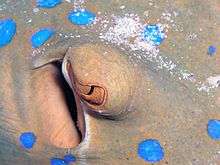Spiracle
Spiracles (/ˈspɪrəkəl/ or /ˈspaɪərəkəl/[1][2]) are openings on the surface of some animals, which usually lead to respiratory systems.
Vertebrates

The spiracle is a small hole behind each eye that opens to the mouth in some fish. In the primitive jawless fish the first gill opening immediately behind the mouth is essentially similar to the other gill opening. With the evolution of the jaw in the early jawed vertebrates, this gill slit was "caught" between the forward gill-rod (now functioning as the jaw) and the next rod, the hyomandibular bone, supporting the jaw hinge and anchoring the jaw to the skull proper. The gill opening was closed off from below, the remaining opening was small and hole-like, and is termed a "spiracle". The spiracle is still found in all cartilaginous fish except requiem sharks, hammerhead sharks, and chimaeras, and is found in some primitive bony fishes, the (coelacanth, sturgeon, paddlefish and bichirs). It is also seen as an otic notch in the skull of the extinct labyrinthodonts, and is thought to be associated with the ear opening in amniotes and frogs.[3]
Arthropods


Insects and some more derived spiders have spiracles on their exoskeletons to allow air to enter the trachea.[4] In the respiratory system of insects, the tracheal tubes primarily deliver oxygen directly into the animals' tissues. The spiracles can be opened and closed in an efficient manner to reduce water loss. This is done by contracting closer muscles surrounding the spiracle. In order to open, the muscle relaxes. The closer muscle is controlled by the central nervous system but can also react to localized chemical stimuli. Several aquatic insects have similar or alternative closing methods to prevent water from entering the trachea. The timing and duration of spiracle closures can affect the respiratory rates of the organism.[5] Spiracles may also be surrounded by hairs to minimize bulk air movement around the opening, and thus minimize water loss.
References
- ↑ Entry "spiracle" in Merriam-Webster Online Dictionary.
- ↑ OED 2nd edition, 1989 as /ˈspaɪərək(ə)l/.
- ↑ Romer, A.S. (1949): The Vertebrate Body. W.B. Saunders, Philadelphia. (2nd ed. 1955; 3rd ed. 1962; 4th ed. 1970)
- ↑ Solomon, Eldra, Linda Berg, Diana Martin (2002): Biology. Brooks/Cole.
- ↑ Wilmer, Pat, Graham Stone, and Ian Johnston (2005). Environmental Physiology of Animals. United Kingdom: Blackwell Publishing. pp. 171–172.
- Chapman, R. F. The Insects. 1998. Cambridge University Press